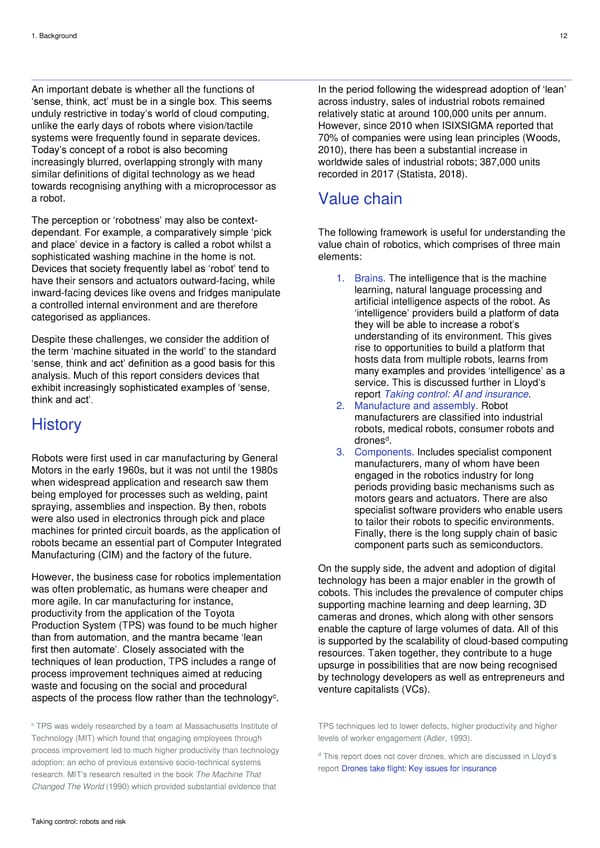1. Background 12 An important debate is whether all the functions of In the period following the widespread adoption of ‘lean’ ‘sense, think, act’ must be in a single box. This seems across industry, sales of industrial robots remained unduly restrictive in today’s world of cloud computing, relatively static at around 100,000 units per annum. unlike the early days of robots where vision/tactile However, since 2010 when ISIXSIGMA reported that systems were frequently found in separate devices. 70% of companies were using lean principles (Woods, Today’s concept of a robot is also becoming 2010), there has been a substantial increase in increasingly blurred, overlapping strongly with many worldwide sales of industrial robots; 387,000 units similar definitions of digital technology as we head recorded in 2017 (Statista, 2018). towards recognising anything with a microprocessor as a robot. Value chain The perception or ‘robotness’ may also be context- dependant. For example, a comparatively simple ‘pick The following framework is useful for understanding the and place’ device in a factory is called a robot whilst a value chain of robotics, which comprises of three main sophisticated washing machine in the home is not. elements: Devices that society frequently label as ‘robot’ tend to 1. Brains. The intelligence that is the machine have their sensors and actuators outward-facing, while learning, natural language processing and inward-facing devices like ovens and fridges manipulate artificial intelligence aspects of the robot. As a controlled internal environment and are therefore categorised as appliances. ‘intelligence’ providers build a platform of data they will be able to increase a robot’s Despite these challenges, we consider the addition of understanding of its environment. This gives the term ‘machine situated in the world’ to the standard rise to opportunities to build a platform that hosts data from multiple robots, learns from ‘sense, think and act’ definition as a good basis for this analysis. Much of this report considers devices that many examples and provides ‘intelligence’ as a service. This is discussed further in Lloyd’s exhibit increasingly sophisticated examples of ‘sense, report Taking control: AI and insurance. think and act’. 2. Manufacture and assembly. Robot History manufacturers are classified into industrial robots, medical robots, consumer robots and d drones . Robots were first used in car manufacturing by General 3. Components. Includes specialist component Motors in the early 1960s, but it was not until the 1980s manufacturers, many of whom have been when widespread application and research saw them engaged in the robotics industry for long being employed for processes such as welding, paint periods providing basic mechanisms such as spraying, assemblies and inspection. By then, robots motors gears and actuators. There are also were also used in electronics through pick and place specialist software providers who enable users machines for printed circuit boards, as the application of to tailor their robots to specific environments. robots became an essential part of Computer Integrated Finally, there is the long supply chain of basic Manufacturing (CIM) and the factory of the future. component parts such as semiconductors. However, the business case for robotics implementation On the supply side, the advent and adoption of digital was often problematic, as humans were cheaper and technology has been a major enabler in the growth of more agile. In car manufacturing for instance, cobots. This includes the prevalence of computer chips productivity from the application of the Toyota supporting machine learning and deep learning, 3D Production System (TPS) was found to be much higher cameras and drones, which along with other sensors enable the capture of large volumes of data. All of this than from automation, and the mantra became ‘lean is supported by the scalability of cloud-based computing first then automate’. Closely associated with the resources. Taken together, they contribute to a huge techniques of lean production, TPS includes a range of upsurge in possibilities that are now being recognised process improvement techniques aimed at reducing by technology developers as well as entrepreneurs and waste and focusing on the social and procedural venture capitalists (VCs). aspects of the process flow rather than the technologyc. c TPS was widely researched by a team at Massachusetts Institute of TPS techniques led to lower defects, higher productivity and higher Technology (MIT) which found that engaging employees through levels of worker engagement (Adler, 1993). process improvement led to much higher productivity than technology d adoption: an echo of previous extensive socio-technical systems This report does not cover drones, which are discussed in Lloyd’s research. MIT’s research resulted in the book The Machine That report Drones take flight: Key issues for insurance Changed The World (1990) which provided substantial evidence that Taking control: robots and risk
 Robots & Risk Page 11 Page 13
Robots & Risk Page 11 Page 13